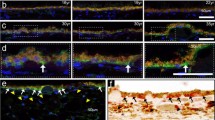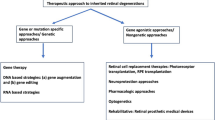Abstract
Purpose
The irreversible death of retinal ganglion cells (RGCs) plays an important role in the pathogenesis of glaucoma. Cellular repressor of E1A-stimulated genes (CREG), a secreted glycoprotein involved in cellular proliferation and differentiation, has been shown to protect against myocardial and renal ischemia‐reperfusion damage. However, the role of CREG in retinal ischemia-reperfusion injury (RIRI) remains unknown. In this study, we aimed to explore the effect of CREG on RGCs apoptosis after RIRI.
Methods
We used male C57BL/6J mice to establish the RIRI model. Recombinant CREG was injected at 1 day before RIRI. The expression and distribution of CREG were examined by immunofluorescence staining and western blotting. RGCs survival was assessed by immunofluorescence staining of flat-mounted retinas. Retinal apoptosis was measured by the staining of TdT-mediated dUTP nick-end labeling and cleaved caspase-3. Electroretinogram (ERG) analysis and optomotor response were conducted to evaluate retinal function and visual acuity. The expressions of Akt, phospho-Akt (p-Akt), Bax, and Bcl-2 were analyzed by western blotting to determine the signaling pathways of CREG.
Results
We found that CREG expression was decreased after RIRI, and intravitreal injection of CREG attenuated RGCs loss and retinal apoptosis. Besides, the amplitudes of a-wave, b-wave, and photopic negative response (PhNR) in ERG, as well as visual function, were significantly restored after treatment with CERG. Furthermore, intravitreal injection of CREG upregulated p-Akt and Bcl-2 expression and downregulated Bax expression.
Conclusion
Our results demonstrated that CREG protected RGCs from RIRI and alleviated retinal apoptosis by activating Akt signaling. In addition, CREG also improved retinal function and visual acuity.





Similar content being viewed by others
Data availability
All the data and results used in this study are available from the corresponding author on reasonable request.
References
Wang Z, Wiggs JL, Aung T et al (2022) The genetic basis for adult onset glaucoma: recent advances and future directions. Prog Retin Eye Res 101066. https://doi.org/10.1016/j.preteyeres.2022.101066
Steinmetz JD, Bourne RRA, Briant PS et al (2021) Causes of blindness and vision impairment in 2020 and trends over 30 years, and prevalence of avoidable blindness in relation to VISION 2020: the right to Sight: an analysis for the global burden of Disease Study. Lancet Glob Health 9:e144–e160. https://doi.org/10.1016/s2214-109x(20)30489-7
Leeman M, Kestelyn P (2019) Glaucoma and blood pressure. Hypertension 73:944–950. https://doi.org/10.1161/HYPERTENSIONAHA.118.11507
Kang JM, Tanna AP (2021) Glaucoma. Med Clin North Am 105:493–510. https://doi.org/10.1016/j.mcna.2021.01.004
Artero-Castro A, Rodriguez-Jimenez FJ, Jendelova P et al (2020) Glaucoma as a neurodegenerative Disease caused by intrinsic vulnerability factors. Prog Neurobiol 193:101817. https://doi.org/10.1016/j.pneurobio.2020.101817
Palmhof M, Frank V, Rappard P et al (2019) From Ganglion cell to photoreceptor layer: Timeline of Deterioration in a rat Ischemia/Reperfusion model. Front Cell Neurosci 13:174. https://doi.org/10.3389/fncel.2019.00174
Chitranshi N, Dheer Y, Abbasi M et al (2018) Glaucoma pathogenesis and neurotrophins: focus on the Molecular and genetic basis for therapeutic prospects. Curr Neuropharmacol 16:1018–1035. https://doi.org/10.2174/1570159X16666180419121247
Adornetto A, Rombola L, Morrone LA et al (2020) Natural Products: evidence for Neuroprotection to be exploited in Glaucoma. Nutrients 12. https://doi.org/10.3390/nu12103158
Veal E, Eisenstein M, Tseng ZH, Gill G (1998) A cellular repressor of E1A-stimulated genes that inhibits activation by E2F. Mol Cell Biol 18:5032–5041. https://doi.org/10.1128/MCB.18.9.5032
Veal E, Groisman R, Eisenstein M, Gill G (2000) The secreted glycoprotein CREG enhances differentiation of NTERA-2 human embryonal carcinoma cells. Oncogene 19:2120–2128. https://doi.org/10.1038/sj.onc.1203529
Liu Y, Tian X, Li Y et al (2016) Up-Regulation of CREG expression by the transcription factor GATA1 inhibits high glucose- and high Palmitate-Induced apoptosis in human umbilical vein endothelial cells. PLoS ONE 11:e0154861. https://doi.org/10.1371/journal.pone.0154861
Liu ML, Song HX, Tian XX et al (2020) Recombinant Cellular Repressor of E1A-Stimulated genes protects against Renal Fibrosis in Dahl Salt-Sensitive rats. Am J Nephrol 51:401–410. https://doi.org/10.1159/000506411
Yang L, Wang W, Wang X et al (2019) Creg in Hepatocytes ameliorates Liver Ischemia/Reperfusion Injury in a TAK1-Dependent manner in mice. Hepatology 69:294–313. https://doi.org/10.1002/hep.30203
Li Y, Zhong W, Huang Q et al (2021) GATA3 improves the protective effects of bone marrow-derived mesenchymal stem cells against ischemic stroke induced injury by regulating autophagy through CREG. Brain Res Bull 176:151–160. https://doi.org/10.1016/j.brainresbull.2021.09.001
Peng CF, Han YL, Jie D et al (2011) Overexpression of cellular repressor of E1A-stimulated genes inhibits TNF-alpha-induced apoptosis via NF-kappaB in mesenchymal stem cells. Biochem Biophys Res Commun 406:601–607. https://doi.org/10.1016/j.bbrc.2011.02.100
Song H, Yan C, Tian X et al (2017) CREG protects from myocardial ischemia/reperfusion injury by regulating myocardial autophagy and apoptosis. Biochim Biophys Acta Mol Basis Dis 1863:1893–1903. https://doi.org/10.1016/j.bbadis.2016.11.015
Palmhof M, Wagner N, Nagel C et al (2020) Retinal ischemia triggers early microglia activation in the optic nerve followed by neurofilament degeneration. Exp Eye Res 198:108133. https://doi.org/10.1016/j.exer.2020.108133
Li Z, Xie F, Yang N et al (2021) Kruppel-like factor 7 protects retinal ganglion cells and promotes functional preservation via activating the akt pathway after retinal ischemia-reperfusion injury. Exp Eye Res 207:108587. https://doi.org/10.1016/j.exer.2021.108587
Yang J, Yang N, Luo J et al (2020) Overexpression of S100A4 protects retinal ganglion cells against retinal ischemia-reperfusion injury in mice. Exp Eye Res 201. https://doi.org/10.1016/j.exer.2020.108281
Mirzayans R, Murray D (2020) Do TUNEL and other apoptosis assays detect cell death in Preclinical Studies? Int J Mol Sci 21. https://doi.org/10.3390/ijms21239090
Yan J, Li Y, Zhang T, Shen Y (2022) Numb deficiency impairs retinal structure and visual function in mice. Exp Eye Res 219:109066. https://doi.org/10.1016/j.exer.2022.109066
Stiles BL (2009) PI-3-K and AKT: onto the mitochondria. Adv Drug Deliv Rev 61:1276–1282. https://doi.org/10.1016/j.addr.2009.07.017
Mathew B, Ravindran S, Liu X et al (2019) Mesenchymal stem cell-derived extracellular vesicles and retinal ischemia-reperfusion. Biomaterials 197:146–160. https://doi.org/10.1016/j.biomaterials.2019.01.016
Tan J, Zhang X, Li D et al (2020) scAAV2-Mediated C3 transferase gene therapy in a rat model with retinal Ischemia/Reperfusion injuries. Mol Ther Methods Clin Dev 17:894–903. https://doi.org/10.1016/j.omtm.2020.04.014
Chang X, Lochner A, Wang H-H et al (2021) Coronary microvascular injury in myocardial infarction: perception and knowledge for mitochondrial quality control. Theranostics 11:6766–6785. https://doi.org/10.7150/thno.60143
Fudalej E, Justyniarska M, Kasarello K et al (2021) Neuroprotective factors of the retina and their role in promoting survival of retinal ganglion cells: a review. Ophthalmic Res 64:345–355. https://doi.org/10.1159/000514441
Xu J, Guo Y, Liu Q et al (2022) Pregabalin mediates retinal ganglion cell survival from retinal Ischemia/Reperfusion Injury Via the Akt/GSK3β/β-Catenin signaling pathway. Invest Ophthalmol Vis Sci 63:7. https://doi.org/10.1167/iovs.63.12.7
Vernazza S, Oddone F, Tirendi S, Bassi AM (2021) Risk factors for retinal ganglion cell distress in Glaucoma and neuroprotective potential intervention. Int J Mol Sci 22. https://doi.org/10.3390/ijms22157994
Wang Y, Jasper H, Toan S et al (2021) Mitophagy coordinates the mitochondrial unfolded protein response to attenuate inflammation-mediated myocardial injury. Redox Biol 45:102049. https://doi.org/10.1016/j.redox.2021.102049
Sun D, Wang J, Toan S et al (2022) Molecular mechanisms of coronary microvascular endothelial dysfunction in diabetes mellitus: focus on mitochondrial quality surveillance. Angiogenesis 25:307–329. https://doi.org/10.1007/s10456-022-09835-8
Almasieh M, Wilson AM, Morquette B et al (2012) The molecular basis of retinal ganglion cell death in glaucoma. Prog Retin Eye Res 31:152–181. https://doi.org/10.1016/j.preteyeres.2011.11.002
Luo J, He T, Yang J et al (2020) SIRT1 is required for the neuroprotection of resveratrol on retinal ganglion cells after retinal ischemia-reperfusion injury in mice. Graefes Arch Clin Exp Ophthalmol 258:335–344. https://doi.org/10.1007/s00417-019-04580-z
Estaquier J, Vallette F, Vayssiere J-L, Mignotte B (2012) The Mitochondrial Pathways of Apoptosis. In: Advances in Mitochondrial Medicine. pp 157–183
Panchal K, Tiwari AK (2019) Mitochondrial dynamics, a key executioner in neurodegenerative diseases. Mitochondrion 47:151–173. https://doi.org/10.1016/j.mito.2018.11.002
Popgeorgiev N, Sa JD, Jabbour L et al (2020) Ancient and conserved functional interplay between Bcl-2 family proteins in the mitochondrial pathway of apoptosis. Sci Adv 6. https://doi.org/10.1126/sciadv.abc4149
Luo H, Zhuang J, Hu P et al (2018) Resveratrol Delays Retinal Ganglion Cell loss and attenuates gliosis-related inflammation from Ischemia-Reperfusion Injury. Invest Ophthalmol Vis Sci 59:3879–3888. https://doi.org/10.1167/iovs.18-23806
Chen D, Zhang Y, Ji L, Wu Y (2022) CREG mitigates neonatal HIE injury through survival promotion and apoptosis inhibition in hippocampal neurons via activating AKT signaling. Cell Biol Int 46:849–860. https://doi.org/10.1002/cbin.11777
McAnany JJ, Persidina OS, Park JC (2022) Clinical electroretinography in diabetic retinopathy: a review. Surv Ophthalmol 67:712–722. https://doi.org/10.1016/j.survophthal.2021.08.011
Wilsey LJ, Fortune B (2016) Electroretinography in glaucoma diagnosis. Curr Opin Ophthalmol 27:118–124. https://doi.org/10.1097/ICU.0000000000000241
Matei N, Leahy S, Blair NP, Shahidi M (2021) Assessment of retinal oxygen metabolism, visual function, thickness and degeneration markers after variable ischemia/reperfusion in rats. Exp Eye Res 213:108838. https://doi.org/10.1016/j.exer.2021.108838
Zhang TZ, Hua T, Han LK et al (2018) Antiapoptotic role of the cellular repressor of E1A-stimulated genes (CREG) in retinal photoreceptor cells in a rat model of light-induced retinal injury. Biomed Pharmacother 103:1355–1361. https://doi.org/10.1016/j.biopha.2018.04.081
Liu Y, McDowell CM, Zhang Z et al (2014) Monitoring retinal morphologic and functional changes in mice following Optic nerve crush. Investig Opthalmology Vis Sci 55:3766. https://doi.org/10.1167/iovs.14-13895
Sarossy M, Crowston J, Kumar D et al (2021) Prediction of glaucoma severity using parameters from the electroretinogram. Sci Rep 11:23886. https://doi.org/10.1038/s41598-021-03421-6
Grillo SL, Montgomery CL, Johnson HM, Koulen P (2018) Quantification of changes in visual function during Disease Development in a mouse model of pigmentary Glaucoma. J Glaucoma 27:828–841. https://doi.org/10.1097/IJG.0000000000001024
Grillo SL, Koulen P (2015) Psychophysical testing in rodent models of glaucomatous optic neuropathy. Exp Eye Res 141:154–163. https://doi.org/10.1016/j.exer.2015.06.025
Feola AJ, Fu J, Allen R et al (2019) Menopause exacerbates visual dysfunction in experimental glaucoma. Exp Eye Res 186:107706. https://doi.org/10.1016/j.exer.2019.107706
Acknowledgements
We thank Jiayi Yang, Xiao Zhang, Ying Li, and Lina Pan for their constructive suggestions.
Funding
None.
Author information
Authors and Affiliations
Contributions
S.Z and L.D designed the study and conducted the experiments. G.L and Y.X reviewed and revised the manuscript. All authors have approved the final article and agree with submission of the manuscript.
Corresponding author
Ethics declarations
Competing Interests
The authors have no relevant financial interests to disclose.
Ethics Approval and Consent to Participate
This study was performed in line with the principles of the National Institutes of Health Guide for the Care and Use of Laboratory Animals. Approval was granted by the Ethics Committee of the Renmin Hospital of Wuhan University.
Consent for Publication
All authors have given their consent to publish this article.
Additional information
Publisher’s Note
Springer Nature remains neutral with regard to jurisdictional claims in published maps and institutional affiliations.
Rights and permissions
Springer Nature or its licensor (e.g. a society or other partner) holds exclusive rights to this article under a publishing agreement with the author(s) or other rightsholder(s); author self-archiving of the accepted manuscript version of this article is solely governed by the terms of such publishing agreement and applicable law.
About this article
Cite this article
Zeng, S., Du, L., Lu, G. et al. CREG Protects Retinal Ganglion Cells loss and Retinal Function Impairment Against ischemia-reperfusion Injury in mice via Akt Signaling Pathway. Mol Neurobiol 60, 6018–6028 (2023). https://doi.org/10.1007/s12035-023-03466-w
Received:
Accepted:
Published:
Issue Date:
DOI: https://doi.org/10.1007/s12035-023-03466-w




